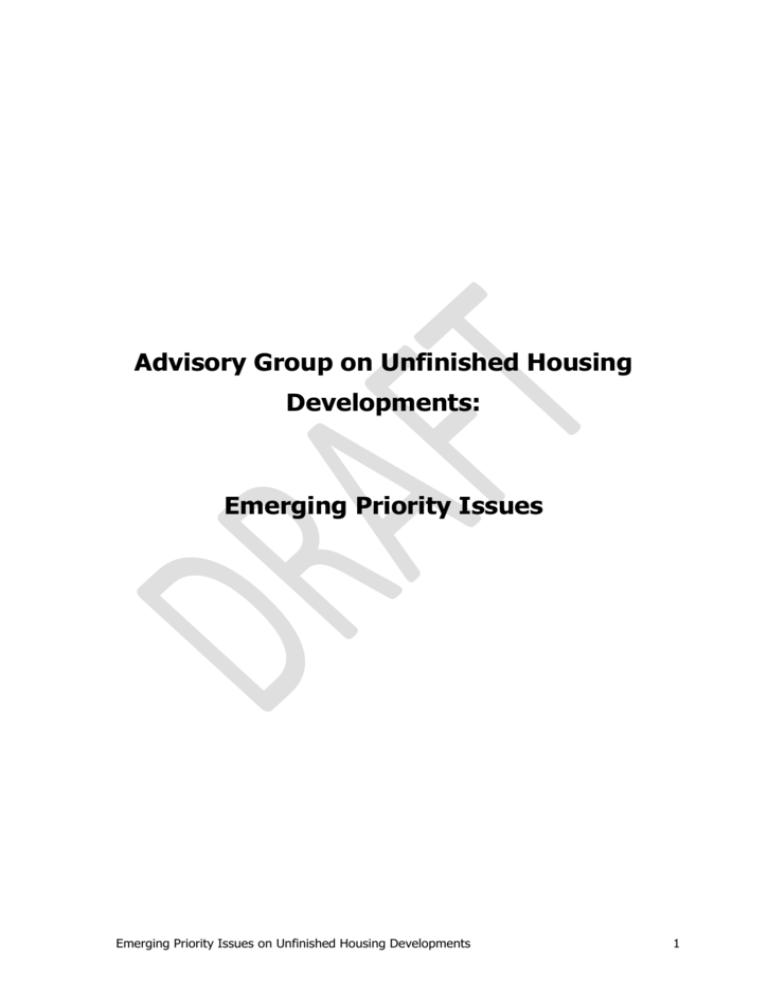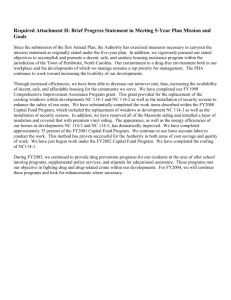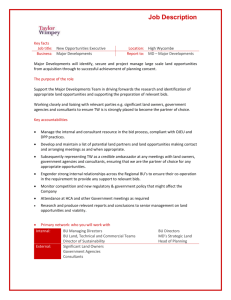Unfinished Housing Developments Interim Report
advertisement

Advisory Group on Unfinished Housing Developments: Emerging Priority Issues Emerging Priority Issues on Unfinished Housing Developments 1 Introduction The issue of unoccupied and unfinished housing estates is a matter of national concern and, in particular, has a serious impact on the residents in a number of the estates. To establish a proper evidence basis for action on unfinished housing developments, the Department of the Environment, Heritage and Local Government carried out a detailed national survey of all commenced housing developments of two houses or more in the State in autumn 2010. A summary of key results are outlined below. Box 1.1: Summary of some of the National Housing Development Survey Key Results Summary of Key Results: 23,250 dwellings at the time of the survey were complete and vacant; 9,976 dwellings were near complete (watertight, but require fitting out or connection to services); Together, there were 33,226 houses that were either complete or near complete and vacant; and 9,854 dwellings were partly constructed. 78,195 dwellings were complete and occupied; The survey (available at www.environ.ie) found that the overhang of new but unoccupied dwellings was relatively modest in the main urbanised areas but more pronounced in areas such as in the Midlands and Border regional authority areas. Emerging Priority Issues on Unfinished Housing Developments 2 The Advisory Group Following the completion of the national survey above, the then Ministers for, Housing and Local Services; and Planning, Sustainable Transport and Horticulture established an Advisory Group on Unfinished Developments to advise the Ministers on actions to ensure the effective management and resolution of unfinished housing developments. Since early November 2010 the Group met on a fortnightly basis. A number of sub-groups were formed to assess specific issues as set out in the terms of reference. An early output was to issue a Draft Manual on Resolving Unfinished Developments for public consultation on the 1st December 2010. The proposed report of the Advisory Group, together with the forthcoming finalised Guidance Manual on Managing and Resolving Unfinished Housing Developments, as well as a Code of Practice will set out ways of resolving challenges faced by these developments. The Scale of the Problem The Advisory Groups first task was to establish the scale of the problem. Many of the housing developments identified in the DEHLG survey were substantially complete and occupied with only later phases of development that were either partly complete or not commenced. Thus, many of the 2,846 housing developments in the DEHLG survey are capable of being addressed through the normal process of developers working with local authorities in completing their developments but in some cases over considerably longer timescales. However, subsequent analysis of the survey also found that there are approximately 400 unfinished developments where there is less than 50% occupancy, meaning large numbers of vacant and part completed dwellings in developments where people are currently living. This represents about 15% of the total number of unfinished developments. Emerging Priority Issues on Unfinished Housing Developments 3 The Group considers that these 400 developments should be a particular focus for more detailed action by developers, funders and local authorities. Taking account of the above, unfinished housing developments can be broadly categorised into the following: 1) A development where the developer is active and the estate is being completed and appropriately managed. 2) A development where a receiver has been appointed and the development is being appropriately managed. 3) A development where the developer is in place but there is no on-site activity and there significant planning, building control compliance and public safety issues to be addressed. 4) A development where the developer or site owner is effectively not contactable and no receiver has been appointed and similar problems to category 3 exist. Categories 1 and 2 can be resolved within the standard procedures that exist, by developers, financial institutions and/or receivers, and may involve interaction with local authority planning sections. Categories 3 and 4 are the ones that require a high level of intervention to bring about some resolution and are of most concern to the advisory group. Category 4 could be called “developer abandoned developments” and these are the developments that require the most attention. Key Issues Facing Residents There are two sets of key issues facing residents of unfinished developments. Firstly, there is the issue of public safety, which arises where part completed elements of housing developments, that are no longer under construction, are poorly fenced leading to the possibility of public access to hazardous areas such as open excavations, piping, unprotected upper floor areas in part completed housing and so on. Emerging Priority Issues on Unfinished Housing Developments 4 Secondly, there are serious completion and compliance issues such as the non completion of public lighting, open space areas or defects with essential services such as water services. These have a major impact on the residents of these developments. Immediate Actions Public safety and critical issues that are having a serious impact on the residents of unfinished developments are an immediate priority. Local Authorities should categorise the developments in their area and prioritise a number of developments to act as demonstration projects in addressing the wider completion and compliance issues mentioned above. One good example for actions to resolve a development is Battery Court in Longford town. Role of the Local Authorities Recognising their normal statutory responsibilities, the role of the Local Authorities should be as follows: 1. To actively support those developments where there is a developer or financier or other stakeholder actively trying to remedy problems. Such intervention may be simply to provide a ‘one stop shop’ to provide linked up housing, planning, infrastructure, community development information on the many aspects of a ‘live’ development. 2. To intervene on a limited number of developments but only as a last resort where there are serious risks to public safety and or public health, and where all other avenues have been exhausted or are unlikely to yield a positive and timely response 3. In the most extreme cases, it may become necessary for the local authority to compulsory acquire all or parts of an estate under the Derelict Sites Act or other legislation. Emerging Priority Issues on Unfinished Housing Developments 5 Site Resolution Plans and Site Action Plans The Group recommends that an important part of the process will be the preparation of site resolution plans (SRPs) by the developer and or owner of each of the developments that have been prioritised for action by the relevant local authority. These plans will set out what should be done to remedy the problems on any given estate and will be a focal point for cooperation between all the stakeholders in resolving problems. Such problems may range from piped services deficiencies, planning and construction regulatory matters, right through to amenity, public lighting, security and health and safety issues. They may propose some targeted demolition. Such plans have been used successfully already by some developers and local authorities and the report will contain details of a case study and methodology for preparing such plans. In the absence or failure of developers and owners to prepare an SRP, then the Group considers there should be an option for local authorities to prepare and implement Site Action Plans (SAPs) as a more straightforward and interim step to help identify and resolve critical issues. Resources to enable local authorities to step in, prepare and implement SAPs on the worst case sites are essential if this is to work but should not be set at such a level as to undermine the process of ensuring that developers and site owners meet their legal and financial obligations. In other words, the SAP route should be reserved for the worst case scenario with full recouping of costs over time from site owners or future developers. Resources The Group believes that the resources to tackle unfinished housing developments must first and foremost come from developers and site owners. Where the above is simply not possible and work on Site Action Plans and or physical works on a site is essential from a public safety or similar perspective, local authorities will require funding support. Emerging Priority Issues on Unfinished Housing Developments 6 The Group recommends that resources be allocated immediately by DEHLG to support the work of local authorities in this regard. The SRP/SAP process may show that for relatively small expenditure, the worst problems in a given development can be resolved. Matching funding could significantly extend the impact of the sum above. Planning Securities Practical experience in the operation of bonds by local authorities indicates that they are very problematic and time consuming to liquidate. As a result residents are left to endure difficult living conditions while the local authority and issuer of the bond work out a solution. In this regard, the view of the Group is that consideration should be given to reverting to the use of more liquid securities such as either cash deposits coupled to careful phasing of developments in a sequential manner to minimise the working capital impact of such an approach or possibly a lien on the title to property controlled by the developer that would be released once the development was satisfactorily completed. This is an area that needs to be examined in more detail. Confidence in New Housing Developments The Group examined the adverse impact that problems and focus on unfinished housing developments have had on consumer confidence in new housing developments, which is important to the creation of good quality urban development and sustainable communities. Prioritised action to deal with the most problematic developments coupled to the emergence of many good practice examples and proper community involvement in the resolution process is essential and can turn around the image of scheme housing. In particular, as many as possible of the 33,000 completed/near complete but vacant housing should be brought into use to the benefit of the economy and local community. Emerging Priority Issues on Unfinished Housing Developments 7 Demand for Housing A key factor in resolving unfinished developments is the level of housing demand. Developments in urban areas where there is an underlying need and demand for housing can be more readily resolved. The greatest difficulty will be addressing and resolving developments in rural, low demand areas. The Planning System The level of overhang of new but vacant housing coupled to existing permissions in all parts of the country but especially the border midlands and western regions needs to be considered by each planning authority in the context of the current process of reviewing all development plans under new 2010 planning legislation. Sligo County Council is one authority working proactively in this regard and that authority has proposed a moratorium on further planning permissions in towns and villages that have an excess of vacant housing and or part completed housing developments. This practice should be adopted more widely in other areas as planning authorities prepare Core Strategies under the changes to planning legislation in 2010. Further Action With concerted and co-ordinated action, the problems associated with unfinished housing developments can be addressed. A National Co-ordination and Advisory Group should be established for the next two years to oversee prioritised action by the various local authorities on the most problematic developments and to monitor progress on the recommendations. Recommendations Detailed recommendations will be developed by the Group but at this stage, it is clear that action on unfinished housing developments will require: a collaborative approach by stakeholders working together to co-ordinate their efforts to resolve the unfinished developments; an immediate focus on public safety aspects and critical issues affecting residents of developments; Emerging Priority Issues on Unfinished Housing Developments 8 the inclusion of residents centrally in the resolution process; a structured and prioritised approach by local authorities supported by central resources; the use of Site Resolution Plans and where appropriate new options such as community involvement, co-operatives and self-build within the resolution process; the continual updating of data and information; national co-ordination and monitoring of regionally and locally organised efforts to tackle the problem. Immediate Recommendation In advance of the completion of the Advisory Group Report it is recommended that urgent action is taken in relation to matters of public safety and critical issues that are seriously affecting residents of unfinished developments. It is recommended that a level of funding is made available for local authorities to take appropriate action and that developments are prioritised for action in each county. Emerging Priority Issues on Unfinished Housing Developments 9







